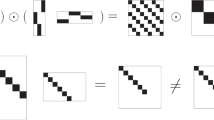Abstract
A new technique for the identification of nonlinearity in multi-degree of freedom systems is presented. The technique is based on the joint application of the Gabor and the Hilbert transforms to the transient response of a system. The Gabor transform is used first to identify a time-variant matrix representing the spatial behaviour of the system. This matrix is then used to decouple the transient response into a set of uncoupled quasi-harmonic components. Finally the Hilbert transform is applied to identify the dissipative and restoring forces associated with each component which is equivalent to a single degree of freedom system. Numerical examples are supplied to help clarify the main advantages and the possible limitations of the method in the presence of strong nonlinearities and closely spaced frequencies.
Similar content being viewed by others
References
Bedrosian, E., ‘A product theorem for Hilbert transform’, Proceeding IRE 51, 1963, 868–869.
Bendat, J. S., The Hilbert Transform and Applications to Correlation Measurement, Bruel & Kjær, Naerum, Denmark, 1986.
Brancaleoni, F., Spina, D., and Valente, C., ‘A free oscillation based technique for the identification of nonlinear dynamic systems’, in Computational and Applied Mathematics, I—Algorithms and Theory, C. Brezinski and U. Kulish (eds.), Elsevier, North-Holland, 1992, pp. 47–54.
Classen, T. A. C. M. and Mecklenbräuker, W. F. G., ‘The Wigner distribution, a tool for time-frequency signal analysis; Part I: Continuous-time signals’, Philips Journal Research 35, 1980, 217–250.
Chiollaz, M. and Favre, B., ‘Engine noise characterization with Wigner-Ville time-frequency analysis’, Mechanical Systems and Signal Processing 7(5), 1993, 375–400.
Chui, C. K., An Introduction to Wavelets, Academic Press, U.K., 1992.
Dahlquist, G. and Bjorck, A., Numerical Methods, Prentice-Hall, NJ, 1974.
Delprat, N., Escudie, B., Guillemain, P., Kronland-Martinet, R., Tchamitchian, P., and Torresani, B., ‘Asymptotic wavelet and Gabor analysis: Extraction of instantaneous frequencies’, IEEE Transactions on Information Theory 38(2), 1992, 644–664.
Feldman, M. and Braun, S. ‘Analysis of typical non-linear vibration systems by using the Hilbert transform’, in Proceedings of the 11th International Modal Analysis Conference, Kissimmee, Florida, 1993, pp. 799–805.
Gabor, D., ‘Theory of communication’, IEE Journal 93, London, 1946, 429–457.
Hammond, J. K. and Davis, P., ‘The use of envelope and instantaneous phase methods for the response of oscillatory non-linear systems to transients’, in Proceedings of the 5th International Modal Analysis Conference, London, 1987, pp. 1460–1465.
Hlawatsch, F., ‘Duality and classification of bilinear time-frequency signal representations’, IEEE Transactions on Signal Processing 39(7), 1991, 1564–1574.
Jones, D. L. and Parks, T. W., ‘A high resolution data-adaptive time-frequency representation’, IEEE Transactions of Acoustic Speech and Signal Processing 18(12), 1990, 2127–2135.
Nayfeh, A. H., Perturbation Methods, Wiley, New York, 1978.
Papoulis, A., Signal Analysis, McGraw-Hill, Singapore, 1984.
Spina, D. and Valente, C., ‘Identification of vibrating components of nonlinear structures’, in Proceeding of the 7th Italian Conference on Computational Mechanics, Trieste, Italy, 1993, pp. 347–352 [in Italian].
Spina, D., ‘Free oscillations analysis of nonlinear systems for mechanical parameters identification’, Ph.D. Thesis, University of Rome “La Sapienza”, Roma, Italy, 1994 [in Italian].
Staszewski, W. J. and Tomlinson, G. R, ‘Application of the avelet transform to fault detection in a spur gear’, Mechanical Systems and Signal Processing 78(3), 1994, 289–307.
Valente, C., ‘Identification of an evolutionary modal model for nonlinear systems’, in Proceedings of the 12th Italian Conference on Theoretical and Applied Mechanics, Napoli, Italy, 1995, Vol. 2, pp. 13–18.
Author information
Authors and Affiliations
Rights and permissions
About this article
Cite this article
Spina, D., Valente, C. & Tomlinson, G.R. A new procedure for detecting nonlinearity from transient data using the gabor transform. Nonlinear Dyn 11, 235–254 (1996). https://doi.org/10.1007/BF00120719
Received:
Accepted:
Issue Date:
DOI: https://doi.org/10.1007/BF00120719




